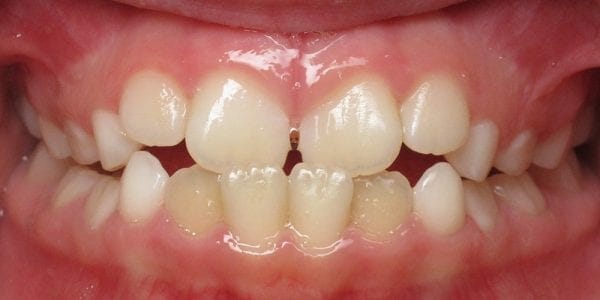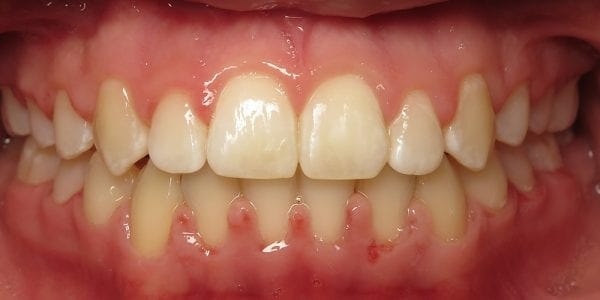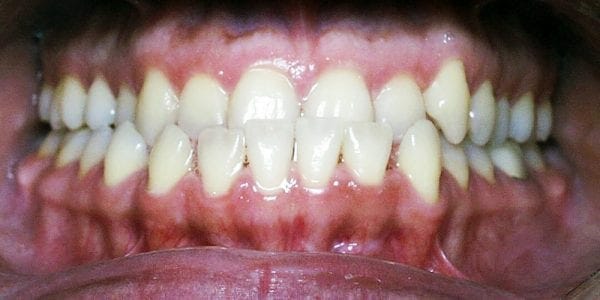Metal (Self Ligating) Braces Before & After
Reveal a Great Smile with Metal Braces in Temecula and Lake Elsinore
Technology and several online and television commercials have educated us on how clear aligners like Invisalign® work, but have you ever thought to yourself, “How do braces work?” More specifically, how do metal braces work?
At Burke and Redford Orthodontists, Dr. Redford is a top pediatric orthodontist who is constantly scouring the marketplace to provide our patients with the newest and best technology in orthodontic care, which includes metal braces. The metal braces you see today may look like yesterday's brackets, but there is much more going on here than meets the eye!
Dr. Ryan Redford uses the best, most effective self-ligating metal braces on the market and are constantly testing new types of metal braces as they become available. You can be assured we will only use the best, safest, and most effective products on the market today.

Long Live Traditional Metal Braces
Traditional metal braces were around before the recent technologies such as Invisalign for teens, also called clear braces, came onto the market. Before the invisible options were available, metal brackets were worn by nearly every teenager on a quest for straighter teeth. Learn more about clear braces vs metal on our Invisalign Temecula as well as our office in Lake Elsinore.
Back then, teens hid their smiles because they were often teased and nicknamed “metal mouth.” Today, those statements are a thing of the past. Braces are now made smaller and are less obscure. Best of all, metal braces for all ages is now the norm.
What are Some of the Types of Metal Braces for Teeth?
Here are three of the most common forms of metal braces available on the market.
Below highlights each and answers the question, “How do braces work?”
- Traditional Metal Braces: Traditional metal braces have a long history of being a very effective device in the orthodontic community. Metal brackets are applied to the front surface of the teeth and act as the anchor for movement of teeth via metal wires. These brackets have a great track record of producing quality results.
- Lingual Braces: Lingual braces are an alternative to traditional metal braces. They are similar in that they act as an anchor point for wires to move the teeth. They differ, however, in that lingual braces are placed on the back surface of teeth. Although they work in much the same way as traditional metal braces, they can be "technique sensitive" (placement and adjustment of braces takes longer), along with speech and comfort being affected negatively. Verbal exercises like “She sells seashells by the seashore” can help patients work through difficulty acclimating to speaking with lingual braces.
- Self-Ligating Braces: Self-ligating braces are another alternative to traditional braces and are available in both metal and clear options. These brackets use special doors or clips to secure the orthodontic wire instead of traditional ligatures (ties that go around each individual bracket). The advantages of self-ligating brackets include less time spent in the dental chair for adjustment appointments, fewer total number of visits to the office during treatment, and an easier time keeping the braces clean (self-ligating brackets are often smoother than traditional brackets). Based on these advantages, we usually prefer this option for having teeth straightened.

A consultation with the doctors of Burke & Redford Orthodontists can provide patients with a comprehensive evaluation and help determine which treatment option will work best.
Compare the look of Ceramic, Clear Braces to Metal Braces.
Self-Ligating Metal and Ceramic Braces for Teens and Children</strong>.
Are Metal Braces a Good Option for My Situation?
Traditional metal braces have been used successfully in virtually every type of orthodontic case. Whether a patient is suffering from crooked teeth, an overbite, an underbite, a crossbite, or any other form of orthodontic problem, metal braces can provide patients with straight teeth, healthy bites, and beautiful smiles.
If you want to compare ceramic braces vs metal, then check out our ceramic braces features and see which options you prefer.
Talented orthodontists like Doctors Redford and Burke understand that teeth straightening is both an art and science. They utilize modern technology, years of industry expertise and a highly trained staff to provide patients with the most advanced form of teeth straightening available on the market. Read the feedback for yourself and discover why Dr. Burke and Dr. Redford have developed such a loyal customer base and continuous referrals every single day.
Do I Have to Get Elastics (rubber bands)?
Yes, wearing elastics in conjunction with braces is an essential component of orthodontic treatment with traditional metal braces, lingual braces, self-ligating braces. Elastics that are placed (by the patient) from top teeth braces to bottom teeth braces are used to provide the force needed to move teeth into the proper bite alignment.
Patients are instructed to wear elastics according to their unique bite relationships, and they can take the form of various configurations. Each time a patient visits our office for an adjustment, elastics are carefully mapped out to ensure treatment is progressing according to plan.
Is Brushing and Flossing Difficult with Metal Braces?
Brushing and flossing may present a few challenges when wearing metal braces, but patients will be given full instructions in overcoming any obstacles they may encounter. After an initial period of getting accustomed to keeping your teeth clean with braces, this will become a simple routine.
What’s most important to remember is that patients must maintain their regular dental hygiene program (even more diligently than before wearing braces).

Are There Any Foods to Avoid?
Patients will want to avoid any food or candy with a hard or sticky consistency. Items like popcorn, gum, taffy, ice and pretzels should be circumvented since they can damage the brackets and wires working to shape your new smile. Should a bracket, wire, or colored rubber band break, the patient should contact our office to have the damaged part repaired. Instances of broken wires, loose braces, or other damaged appliances can increase treatment time and prevent the ability to make consistent progress in achieving a great result.
Metal Braces Cost
Since every case and patient is completely unique, we offer a free, no-obligation consultation and treatment plan recommendation with your cost. Our staff helps with financing options and insurance to make smile transformations to a healthier bite an enjoyable experience.
Are Burke & Redford Orthodontists Experienced?
The Temecula and Lake Elsinore offices are led by two of the most high-qualified, experienced family orthodontists who have over 36 years of experience treating every type of orthodontic problem. They consider and take full advantage of the latest trends in technology, employ a staff who specializes in creating a patient-centric environment and have created a safe, comfortable office readily available to meet the needs of all patients.
Frequently Asked Questions About Metal Braces
How do metal dental braces work at Burke & Redford Orthodontists, and can I call to learn more?
At Burke & Redford Orthodontists, Dr. Ryan Redford uses metal dental braces (including advanced self‑ligating styles) to gently apply continuous pressure via brackets and archwires, moving teeth into proper alignment. Call us to schedule a free consultation and see if this is the right option for you.
Are metal braces a good option for children, teens, or adults?
Yes. Burke & Redford Orthodontists has treated patients of all ages: kids, teens, and adults, with metal braces to correct issues such as crowding, spacing, overbites, underbites, and crossbites. Call to request a free consultation and have Dr. Ryan Redford evaluate your unique case and recommend the best treatment path.
Will metal braces be painful, and what should I expect during adjustment visits?
Burke & Redford Orthodontists, under Dr. Ryan Redford’s care, aims to make the process as comfortable as possible. You may feel pressure or mild soreness when metal braces are first placed or after adjustments, but this usually lessens in a few days. Give us a call if you would like us to walk you through what your first few appointments will feel like.
What care is needed with metal braces, and what foods should be avoided?
Maintaining your metal braces with Burke & Redford Orthodontists takes a bit more diligence: brushing carefully around brackets, flossing under wires, and using tools like interdental brushes. Avoid hard or sticky foods (ice, gum, caramel, popcorn) that could damage brackets or wires. Call us if a wire or bracket breaks since prompt repairs help keep treatment on schedule.
How do I schedule a free orthodontic consultation with Dr. Ryan Redford, and what happens during that visit?
At Burke & Redford Orthodontists, a free orthodontic consultation with Dr. Ryan Redford includes a detailed evaluation of bite alignment, dental spacing and crowding, X‑rays or scans as needed, and a discussion of metal braces vs other options. We also review financing and insurance. Contact us to request your appointment and take the first step towards a confident smile.
Burke & Redford Orthodontists are also the best children’s orthodontists. So, if you have a family with kids who are apprehensive or nervous (due to a previous poor dental experience or fear of the unknown), a visit to the office of Dr. Burke and Dr. Redford can help to radically turn that frown into a sparkling new smile.
If you’re seeking an affordable orthodontist, inquire about the variety of payment options available. There is at least one option to meet nearly every patient’s needs, and the trained administrative staff help you with all the insurance paperwork.
Our Team of Professional are Here for You
Contact Burke & Redford Orthodontists in Temecula or in Lake Elsinore by calling our main office at (951) 699-8011 or fill out the Schedule a Consultation form on our website anytime. We will schedule a time that works with your schedule to discuss “How do braces work?” and how the partnership with an expert Temecula orthodontist can work best for you.



